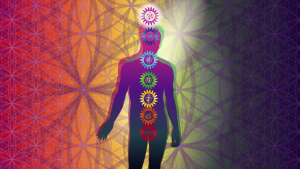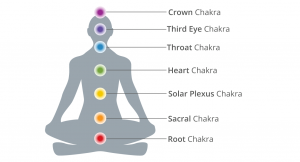Ayurveda originates from two Sanskrit words Ayur (life) and Veda (knowledge) – knowledge on how to live. It is emphasised that it is the sole responsibility of the individual to maintain good health. The origins of Ayurveda have been traced back to around 5,000 BCE when they originated as an oral tradition. Some of the concepts of Ayurveda have existed since the times of the Indus Valley Civilization.
The first recorded forms of Ayurveda as medical texts evolved from the Vedas. Illness is seen as an imbalance – using herbs can restore equilibrium. Ayurvedic tradition emphasises a “holistic” approach to treating the person’s mind body and spirit with the appropriate remedies. It links the microcosm of the individual with the cosmos. According to Ayurveda, the source of all existence is universal Cosmic Consciousness, which manifests as male and female energy.

Primal Forces
At the heart, we have three primal forces:
Prana – the breath of life
Agni – the spirit of light or fire
Soma – the manifestation of harmony and love

The Five Elements of Matter
Earth – Neutralising & Solidifying
All plants, vegetables and fruits spring from the Earth, which humans use for survival. The Earth is also the source of all building materials that humans use to create homes, schools and businesses. Much like water, major industries are dependent on the Earth to function. When the earth element is out of balance, earthquakes and famines can occur.
Water – The Lifeline of existence
The blood that runs through the human body is composed predominately of water. Just as the earth is composed primarily of bodies of water. Not only is water crucial for the basic survival of plants, animals and humans. It is also vital to maintain hygiene and cleanliness. Rivers, which are venerated in Hindu society, are indispensable as they cater to personal and industrial requirements. Water, therefore, is revered as the crux of civilization. Hindus believe that when the water element is out of balance, natural disasters such as tsunamis, hurricanes and floods occur.
Fire – Source of warmth and illumination
Without the rays of the sun, the Earth would be shrouded in darkness and ignorance. Without heat in the body, people wouldn’t survive the elements or burnout disease. Hindus venerate the fire element because it is used to cook food that nourishes the body. Just as with the other elements, it is also essential to industry, as it is the cause of electricity.
Air – Creates and sustains life through breath
In Hindu philosophy, air is called prana, a Sanskrit word that is directly related to breath. Air also nourishes plants in the form of oxygen.
Ether – Sprit/Space or Sky
Ties all of the other four elements together. It is within the space of ether that they can thrive. It is the highest, yet the most subtle of the elements.


Doshas – means “that which can go out of balance or that which is impure.”
What Are the Doshas?
The human body is made up of the five elements: earth, water, fire, air and ether. Each of these elements has its own properties and characteristics. Each element also has its impact on the human body and mind. In Ayurveda, these five elements manifest through the 3 Doshas. Doshas are natural principles that can be found in all things in nature including people. If there is an imbalance between them then it leads to various diseases and disorders. Let us take a look at what the Doshas are and how you can balance them.
Doshas are the three types of bio-energies that influence the body and mind. These energies are responsible for all activities that take place in the body, including digestion, metabolism and immunity. The three Doshas are –
Vata
It is the bio-energy of air and ether. It is responsible for the transformation of food and its conversion into energy. Vata is present in our nervous system, digestive system and respiratory system. It is responsible for sending oxygen to our cells and tissues. Vata is present in our blood as well as our sweat.
Pitta
It is the bio-energy of fire and water. It is responsible for all metabolic activities in the body. It converts food into energy, nutrients and other substances. It is responsible for the digestion, absorption and excretion of toxins. Pitta is present in the digestive system and the liver. It is responsible for the secretion of insulin. It is also present in the eyes and skin.
Kapha
It is the bio-energy of water and earth. It is responsible for providing the body with immunity and enhancing its ability to repair itself. It is also responsible for the body’s ability to fight infections. Kapha is present in the lungs and respiratory system. It is present in the mouth, tongue and tissues as well. It is also present in the white blood cells, spleen and lymph nodes.
How to Balance the Doshas
The main objective of Ayurvedic practices is to maintain the balance between the Doshas. Ayurveda suggests that the best way to stay healthy and fit is by keeping your Doshas in balance. The best way to find out if the Doshas are imbalanced is to take an Ayurvedic health check-up. An Ayurvedic doctor will analyse your body’s energy, digestive system and immunity. They will then suggest ways to manage your Doshas based on their analysis of you.
Doshas are natural principles that can be found in all things in nature including people. If there is an imbalance between them then it leads to various diseases and disorders. The best way to stay healthy and fit is by keeping your Doshas in balance by following a healthy diet, regular exercise, and by utilising relaxation techniques such as yoga, massage, and meditation.

Treatment
Food, drink, sensual gratification and light fresh and spiritual activities are used to feed the digestive fire and produce the correct mix of doshas.
Health problems associated with excess phlegm such as catarrh, oedema or water retention can be treated with warm, light dry foods, fasting, and avoiding cold drinks that would increase Kapha. Herbal remedies may include hot spices such as cayenne, pippali and cinnamon. Bitters such as aloe or turmeric; pungent tonics like saffron and stimulating mind-clearing herbs such as Gotu Kola. Guggal or myrrh are all designed to dry excess water or phlegm.
Taste is also a major factor; pungent and bitter herbs can reduce Kapha so the diet would favour these over sweet, salty, or sour flavours. Treatment may also include massage with herbal oils such as eucalyptus, burning pungent incense such as frankincense and encouraging the sufferer to wear bright hot reds and yellows instead of cool colours like blue and white.

Other Principles
The Ayurvedic approach concentrates on remedies for an individual’s mind body and spirit which can include meditation, physical exercise or herbs which focus on a particular aspect of being. Heart issues for example are considered as much a spiritual problem as pathology since the heart is the seat of the atman or divine self. Herbs to treat such conditions might include arjuna – used as a heart tonic and sandalwood massage oil to calm and uplift the spirit and encourage joy. The essential energy of the body like Chinese qi/chi or vril can be strengthened with herbs such as ashwagandha, Shatavari or Guduchi.
The Chakras – An Overview

Crown Chakra
Associated with the pineal gland. Herbs – Any that are considered Sacred, those that cleanse or that have energising benefits.
Third Eye Chakra
Linked to the third eye and the pituitary gland. Supported by Passion Flower and Lavender or any herbs or spices that benefit the mind or nervous system.
Throat Chakra
Associated with the thyroid gland. Strengthen with any blue herbs or herbs/spices that benefit the lungs.
Heart Chakra
Linked to the thymus gland and heart. Helped by Parsley, Cilantro and Cayenne or herbs/spices that help the heart or blood.
Solar Plexus Chakra
Associated with the liver and adrenal gland. Supported by herbs such as Turmeric or herbs/spices that aid digestion.
Sacral Chakra
Linked to the testes and ovaries. Strengthen with Damiana or herbs that benefit the reproductive system such as Maca or Tongkat Ali.
Root Chakra
Associated with the uterus and prostate gland. Herbs used to help include Ashwagandha and any “grounding” herbs such as Astragalus.
We will dive more in-depth into the 7 chakras in the next blog post!
